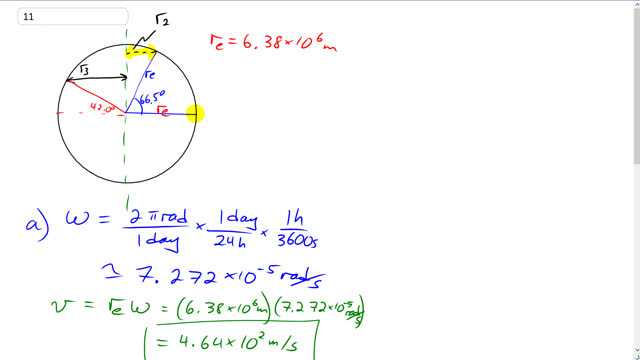
What is the linear speed, due to the Earth’s rotation, of a point
- on the equator,
- on the Arctic Circle (latitude N), and
- at a latitude of N?

In order to watch this solution you need to have a subscription.
This is Giancoli Answers with Mr. Dychko. To calculate the linear speed of a point on the surface of the Earth, we need to know the distance from that point to the axis of rotation. So on the equator that distance is gonna be the radius of the Earth and we'll multiply that radius by the angular speed of the Earth to get the linear speed of that point on the equator. So the angular speed of the Earth is one full revolution of 2π radians per day times by 1 day for every 24 hours and then times by 1 hour for every 3600 seconds and we get 7.272 times 10 to the minus 5 radians of earth rotation per second. So multiply that angular velocity by the radius of the Earth which is the distance from the equator to the axis of rotation and we get 4.64 times 10 to the 2 meters per second. Then when you are on the arctic circle at a latitude of 66.5 degrees, you're this distance r 2 away from the axis of rotation and we could, you know, take this triangle over here for a second just to make it a bit more clear on its own and what we are really doing is we are finding this distance r 2 where this is the 66.5 degree angle right there. So I have rewritten this r 2 there down here instead on this picture. So I did that to show that this is the adjacent leg in this right triangle. And so we can use cos, multiply by the length of the hypotenuse which is the Earth's radius to figure out this r 2. Okay. And that will be the same process for finding r 3 as well. So the distance from the axis rotation is the radius of the Earth times cos 66.5 degrees times the angular velocity which gives 185 meters per second for the linear speed at the arctic circle. And for this latitude of 42.0 degrees, it's 6.38 times 10 to the 6 meters— radius of the Earth—times cos 42 times 7.272 times 10 to the minus 5 radians per second—angular velocity— and that makes 345 meters per second.